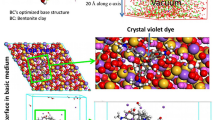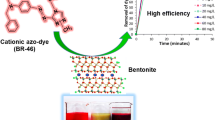Abstract
The sorption behaviors of brilliant blue FCF dye by natural clay and modified with iron chloride were determined. The materials were characterized by X-ray diffraction and scanning electron microscopy, and the zero point charges were also determined. The effects of pH, contact time, dye concentration, and temperature were considered. The results showed that clay does not suffer any important change in its structure after the chemical treatments. The pH influences the sorption of the dye in the unmodified clay, but this effect was not observed in the iron-modified clay. The equilibrium time and the sorption capacity for the unmodified clay were 48 h and 6.16 mg/g, while for the iron-modified clay, 24 h and 14.22 mg/g, respectively. The sorption kinetics results were best adjusted to the pseudo-first-order and pseudo-second-order models. Sorption isotherms were best adjusted to the Langmuir model, indicating that both clays have a homogeneous surface. Thermodynamic parameters (E, ΔS, ΔG and ΔH) were calculated for the natural clay from the data of the sorption kinetics at temperatures between 20 and 50 °C, indicating that the sorption process is exothermic. For the case of the iron-modified clay, it was not possible to calculate these thermodynamic parameters because the sorption capacities were similar in the temperature range selected.








Similar content being viewed by others
References
Abou-Mesalam, M. M. (2004). Applications of inorganic ion exchangers: II—adsorption of some heavy metal ions from their aqueous waste solution using synthetic iron III titanate. Adsorption, 10, 87–92.
Akhtar, M., Hasany, S. M., Bhanger, M. I., & Iqbal, S. (2007). Low cost sorbents for the removal of methyl parathion pesticide from aqueous solutions. Chemosphere, 66, 1829–1838.
Al-Ghouti, M., Khraisheh, M. A. M., Ahmad, A. N. M., & Allen, S. (2005). Thermodynamic behavior and the effect of temperature on the removal of dyes from aqueous solution using modified diatomite: a kinetic study. Journal of Colloid and Interface Science, 287, 6–13.
Chang, R. (2007). Química (9th ed.). Mexico: McGraw Hill Interamericana S.A. de C.V.
Cortés, R., Martínez, V., & Solache, M. (2004). Evaluation of natural and surfactant-modified zeolites in the removal of cadmium from aqueous solutions. Separation Science and Technology, 39, 2711–2730.
Crini, G. (2006). Non-conventional low-cost adsorbents for dye removal: a review. Bioresource Technology, 97, 1061–1085.
Eren, E. (2009). Investigation of a basic dye removal from aqueous solution onto chemically modified Unye bentonite. Journal of Hazardous Materials, 166, 88–93.
Errais, E., Duplay, J., Darragi, F., M’Rabet, I., Aubert, A., Huber, F., et al. (2011). Efficient anionic dye adsorption on natural untreated clay: kinetic study and thermodynamic parameters. Desalination, 275, 74–81.
Flury, M., & Flühler, H. (1994). Brilliant blue FCF as a dye tracer for solute transport studies—a toxicological overview. Journal of Environmental Quality, 23, 1108–1112.
Gil, A., Assis, F. C. C., Albeniz, S., & Korili, S. A. (2011). Removal of dyes from wastewaters by adsorption on pillared clays. Chemical Engineering Journal, 168, 1032–1040.
Gök, O., Özcan, A. S., & Özcan, A. (2010). Adsorption behavior of a textile dye of Reactive Blue 19 from aqueous solutions onto modified bentonite. Applied Surface Science, 256, 5439–5443.
Gutiérrez-Segura, E., Solache-Ríos, M., & Colín-Cruz, A. (2009). Sorption of indigo carmine by a Fe-zeolitic tuff and carbonaceous material from pyrolyzed sewage sludge. Journal of Hazardous Materials, 170, 1227–1235.
Ho, Y. S., Chiu, W. T., Hsu, C. S., & Huang, C. T. (2004). Sorption of lead ions from aqueous solution using tree fern as a sorbent. Hydrometallurgy, 73, 55–61.
Ho, Y. S., & McKay, G. (2002). Application of kinetic models to the sorption of copper(II) on to peat. Adsorption Science and Technology, 20, 797–813.
Islem, C., Mongi, F., Mounir, M., Jalel, B., Emna, F., & Fakher, J. (2009). Adsorption of a textile dye “Indanthrene Blue RS (C.I. Vat Blue 4)” from aqueous solutions onto smectite-rich clayey rock. Journal of Hazardous Materials, 172, 1623–1628.
Lee, S. M., & Tiwari, D. (2012). Organo and inorgano-organo-modified clays in the remediation of aqueous solutions: an overview. Applied Clay Science, 59–60, 84–102.
Lian, L. L., Guo, L., & Guo, C. (2009). Adsorption of Congo red from aqueous solutions onto Ca-bentonite. Journal of Hazardous Materials, 161, 126–131.
Malik, U. R., Hasany, S. M., & Subhani, M. S. (2005). Sorptive potential of sunflower stem for Cr(III) ions from aqueous solutions and its kinetic and thermodynamic profile. Talanta, 66, 166–173.
Otero, M., Rozada, F., Calvo, L. F., García, A. I., & Morán, A. (2003). Elimination of organic water pollutants using adsorbents obtained from sewage sludge. Dyes and Pigments, 57, 55–65.
Pinedo-Hernández, S., Díaz-Nava, C., & Solache-Ríos, M. (2012). Sorption behavior of brilliant blue FCF by a Fe-zeolitic tuff. Water, Air, and Soil Pollution, 223, 467–475.
Roulia, M., & Vassiliadis, A. A. (2008). Sorption characterization of a cationic dye retained by clays and perlite. Microporous and Mesoporous Materials, 116, 732–740.
Salinas-Hernández, C., Díaz-Nava, M. C., & Solache-Ríos, M. (2012). Sorption and desorption of red 5 and yellow 6 by a Fe-zeolitic tuff. Water, Air, and Soil Pollution, 223, 4959–4968.
Sun Kou, M.R., Volzone, C., Sapag, K., (2004). Adsorbentes en la solución de algunos problemas ambientales. Capitulo 10: las arcillas y sus diferentes aplicaciones en sorción. Red Iberoamericana de Adsorbentes para la Protección Ambiental. 167–169.
Torres-Pérez, J., Solache-Ríos, M., & Colín-Cruz, A. (2008). Sorption and desorption of dye Remazol yellow onto a Mexican surfactant-modified clinoptilolite-rich tuff and a carbonaceous material from pyrolysis of sewage sludge. Water, Air, and Soil Pollution, 187, 303–313.
Unuabonah, E., Adebowale, K. O., & Dawodu, F. A. (2008). Equilibrium, kinetic and sorber design studies on the adsorption of aniline blue dye by sodium tetraborate-modified kaolinite clay adsorbent. Journal of Hazardous Materials, 157, 397–409.
Acknowledgments
We acknowledge the financial support from CONACYT project 131174Q.
Author information
Authors and Affiliations
Corresponding author
Rights and permissions
About this article
Cite this article
Hernández-Hernández, K.A., Solache-Ríos, M. & Díaz-Nava, M.C. Removal of Brilliant Blue FCF from Aqueous Solutions Using an Unmodified and Iron-Modified Bentonite and the Thermodynamic Parameters of the Process. Water Air Soil Pollut 224, 1562 (2013). https://doi.org/10.1007/s11270-013-1562-9
Received:
Accepted:
Published:
DOI: https://doi.org/10.1007/s11270-013-1562-9




